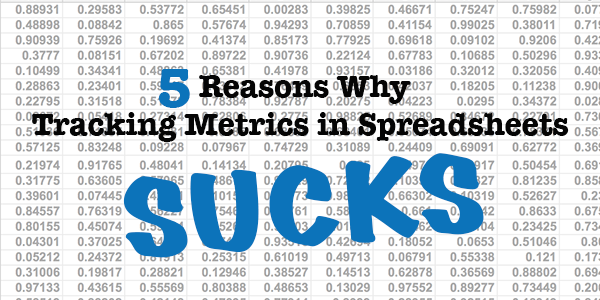
Raise your hand if you love tracking metrics in spreadsheets.
Anyone? Anyone?

That’s what we thought.
Trying to track metrics in a spreadsheet is a painstaking, pull-your-hair-out process that takes up valuable time—something most marketers don’t have enough of already.
But in the age of content dominating the B2B space, marketers are hungry for metrics to track their content impact. But the problem most marketers face is not knowing how and what to measure.
Only 21% of marketers say they are successful at tracking ROI
Only 21% of marketers say they are successful at tracking ROI, according to the Content Marketing Institute’s 2015 Benchmark Study.
Where does that leave the other 79%? They are likely sorting through data in a clunky spreadsheet, wondering where the last three hours went, with no real insights on how their content is affecting their bottom line. You deserve something better than Google Docs or Excel.
To give you a break from your spreadsheet nightmare, here are five reasons why tracking metrics in spreadsheets sucks.
1. Manual Data Entry

We’re laughing only out of sympathy, because it doesn’t have to be that way.
From email to social, the modern marketer lives in a world of automation—so why isn’t your metrics dashboard following suit? Pulling analytics from 20 different tools with conflicting formats and units of measurement equates to a lot of time spent manually entering and cleaning up data. Sound familiar? Cue nervous laughter.
2. You’re a Marketer, Not a Developer
Is it possible to connect APIs into a spreadsheet for a more automated system? Sure. Is it easy? No.
Accountants have been using spreadsheets for hundreds of years, but the modern marketer isn’t tracking accounts receivable. B2B marketers track a slew of metrics from email opens and click-throughs, to more complicated conversion rates and scoring. To create an automated spreadsheet that captures this data requires some serious coding, and that still doesn’t guarantee you’re getting the insights you need.
Which brings us to the next point.
3. The Potential for Mistakes Is Everywhere

If there’s one thing we know for sure, it’s that marketers are busy. The last thing you want to do, or have time to do, is put out spreadsheet fires. Whether it’s lost data, a miscalculation, or a coding error, finding the bug isn’t often a simple task and you run the risk of losing historical data and/or duplicating work.
4. Spreadsheets Are a Black Hole for Time

The simple truth about spreadsheets is that they weren’t created for managing marketing metrics. A good marketer constantly tests new initiatives and evolves their content operation—so if you’re tracking metrics in a spreadsheet, be prepared to regularly update and overhaul how you are using it.
At its core, using a spreadsheet to track your metrics is nothing more than a time-consuming work-around solution—emphasis on time-consuming.
5. What’s My Password?

It’s Monday morning and it’s time to pull in the metrics from last week. But first, “What’s my password, again?”
One of the most frustrating parts of using a spreadsheet to track metrics is that there is no central login or location that houses all of your measurement tools. Before you can even begin pulling in your stats, you must first log in to all of the sites where you collect data. Too many passwords, too many tabs, and too many tools that don’t sync together cause too many headaches and not enough insights. Yikes.
There’s a better way to track marketing success. Time to get out of spreadsheet hell.


